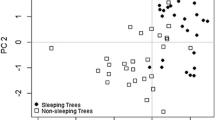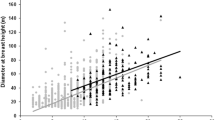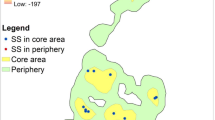Abstract
Data on sleeping site selection were collected for a group of black-and-white snub-nosed monkeys (Rhinopithecus bieti; around 80) at Mt. Fuhe, Yunnan, China (99°20′E, 26°25′N, about 3,000 m asl) from November 2000 to January 2002. At the site mainly three vegetation types were present in an elevation-ascending order: deciduous broad leaf forest, mixed coniferous and broad leaf forest, and dark coniferous forest. In addition, bamboo forest presented in areas burned in 1958. Sleeping sites (n =10) were located in the coniferous forest, where trees were the tallest, bottommost branches were the highest, the diameter of crowns was the second largest, and the gradient of the ground was the steepest. Monkeys usually kept quiet during entering and staying at a sleeping site. The site choice and the quietness may be tactics to avoid potential predators. In the coniferous forest, however, monkeys did not sleep in the valley bottom where trees were the largest, but frequently slept in the middle of the slope towards the east/southeast, in the shadow of ridges in three other directions, to avoid strong wind and to access sunshine; in winter-spring, they ranged in a more southern and lower area than in summer-autumn. These may be behavioral strategies to minimize energy stress in the cold habitat. Monkeys often slept in the same sleeping site on consecutive nights, which reflected a reduced pressure of predation probably due to either the effectiveness of anti-predation through sleeping site selection, or the population decline of predators with increasing human activities in the habitat. The group’s behavioral responses to interactive and sometimes conflicting traits of the habitat are site-specific and conform to expectations for a temperate zone primate.


Similar content being viewed by others
References
Altman SA, Altman J (1970) Baboon ecology. Karger, Basel
Anderson JR (1984) Ethology and ecology of sleep in monkeys and apes. In: Rosenblatt JS, Beer C, Busnel M-C (eds) Advances in the study of behavior, vol. 14. Academic, New York, pp 165–229
Anderson JR (1998) Sleep, sleeping sites, and sleep-related activities: awakening to their significance. Am J Primatol 46:63–75
Ansorge V, Hammerschmidt K, Todt D (1992) Communal roosting and formation of sleeping clusters in Barbary macaques (Macaca sylvanus). Am J Primatol 28:271–280
Aquino R, Encarnación F (1986) Characteristics and use of sleeping sites in Aotus (Cebidae: Primates) in the Amazon Lowlands of Peru. Am J Primatol 11:319–331
Bishop NH (1979) Himalayan langurs: temperate colobine. J Hum Evol 8:251–281
Caine NG (1987) Vigilance, vocalizations, and cryptic behavior at retirement in captive groups of red-bellied tamarins (Saguinus labiatus). Am J Primatol 12:241–250
Caine NG, Potter MP, Mayer KE (1992) Sleeping site selection by captive tamarins (Saguinus labiatus). Ethology 90:63–71
Chapman CA (1989) Spider monkey sleeping sites: use and availability. Am J Primatol 18:53–60
Chivers DJ (1969) On the daily behaviour and spacing of howling monkey groups. Folia Primatol 10:48–102
Cowlishaw G (1994) Vulnerability to predation in baboon populations. Behaviour 131:293–304
Cui LW (2003) A note on an interaction between Rhinopithecus bieti and a buzzard at Baima Snow Mountain. Folia Primatol 74:51–53
Deng SM, Zhang PC (1997) The forestry annals of Lanping Baizu and Primi autonomy county. Yunnan Ethical Press, Yunnan, pp 100–111
Di Bitetti MS, Vidal EML, Baldovino MC, Benesovsky V (2000) Sleeping site preferences in tufted capuchin monkeys (Cebus apella nigritus). Am J Primatol 50:257–274
Ding W, Zhao Q-K (2004) Rhinopithecus bietiat Tacheng, Yunnan: diet, and daytime activities. Int J Primatol 25:583–598
Eisenberg JF, Dittus WPJ, Fleming TH, Green K, Struhsaker T, Thorington RW (1981) Techniques for the study of primate population ecology. National Academy Press, Washington, D.C., pp 21–22
Elliot DG (1912) A review of primates. Monographs of the American Museum of Natural History, vol III: Anthropoidea. American Museum of Natural History, New York, pp 103
Furuichi T, Takasaki H, Sprague DS (1982) Winter range utilization of a Japanese macaque troop in a snowy habitat. Folia Primatol 37:77–94
Gittins SP (1982) Feeding and ranging in the agile gibbon. Folia Primatol 38:39–71
Hamilton WJ (1982) Baboon sleeping site preferences and relationships to primate grouping patterns. Am J Primatol 3:41–53
Heymann EW (1995) Sleeping habits of tamarins, Saguinus mystax and Saguinus fuscicollis (Mammalia, Primates, Callitrichidae), in north-eastern Peru. J Zool 237:211–226
Hippel FA von (1998) Use of sleeping trees by black and white colobus monkeys (Colobus guereza) in the Kakamega. Am J Primatol 45:281–290
Kappeler PM (1998) Nests, tree holes, and the evolution of primate life histories. Am J Primatol 46:7–33
Kirkpatrick RC (1996) Ecology and behavior of the Yunnan snub-nosed langur (Rhinopithecus bieti, Colobinae). PhD dissertation, University of California
Kirkpatrik RC, Long YC, Zhong T, Xiao L (1998) Social organization and range use in the Yunnan snub-nosed monkey Rhinopithecus bieti. Int J Primatol 19:13–51
Li BG, Chen C, Ji WH, Ren BP (1999) Seasonal home range changes of the Sichuan snub-nosed monkey (Rhinopithecus roxellana) in the Qinling Mountains of China. Folia Primatol 71:375–386
Long Y-C, Kirkptrick RC, Zhong T, Xiao L (1994) Report on the distribution, population, and ecology of the Yunnan snub-nosed monkey (Rhinopithecus bieti). Primates 35:241–250
McGarigal K, Cushman S, Stafford S (2000) Multivariate statistics for wildlife and ecology research. Springer, Berlin Heidelberg New York, pp 19–78
Nishida T (1987) Local traditions and cultural transmission. In: Smuts BB, Cheney DL, Seyfarth RM, Wrangham RW, Struhsaker TT (eds) Primate societies. University of Chicago Press, Chicago, Ill., pp 462–474
Oates JF (1987) Food distribution and foraging behavior. In: Smuts BB, Cheney DL, Seyfarth RM, Wrangham RW, Struhsaker TT (eds) Primate societies. University of Chicago Press, Chicago, Ill., pp 197–209
Pirta RS (1982) Socioecology and conservation of macaques and langurs in Varanassi, India. Am J Primatol 2:401–403
Raemaekers JJ, Chivers DJ (1980) Socio-ecology of Malayan forest primates. In: Chivers DJ (ed) Malayan forest primates: ten years’ study in tropical rain forest. Plenum Press, New York, pp 279–316
Reichard U (1998) Sleeping sites, sleeping places, and presleep behavior of gibbon (Hylobates lar). Am J Primatol 46:35–62
Schaller GB (1985) China’s golden treasure. Int Wildl 5:29–31
Struhsaker TT, Leakey M (1990) Prey selectivity by crowned hawk-eagles on monkeys in the Kibale forest, Uganda. Behav Ecol Sociobiol 26:435–443
Suzuki A (1965) An ecological study of wild Japanese monkeys in snowy areas-focused on their food habits. Primates 10:103–148
Tenaza RR, Tilson RL (1985) Human predation and Kloss’s gibbon (Hylobates klossii) sleeping trees in Siberut Island, Indonesia. Am J Primatol 8:299–308
Wada K, Ichiki Y (1980) Seasonal home range use by Japanese monkeys in the Shiga Heights. Primates 21:468–483
Wada K, Tokida E (1981) Habitat utilization by wintering Japanese monkeys (Macaca fuscata fuscata) in the Shiga Heights. Primates 22:330–348
Xiao W, Ding W, Cui L-W, Zhou R-J, Zhao Q-K (2003) Habitat degradation of Rhinopithecus bieti in Yunnan, China. Int J Primatol 24:389–398
Yang SJ, Zhao Q-K (2001) Bamboo leaf-based diet of Rhinopithecus bieti at Lijiang, China. Folia Primatol 72:92–95
Zhao Q-K (1999) Responses to seasonal changes in nutrient quality and patchiness of food in a multigroup community of Tibetan macaques at Mt. Emei. Int J Primatol 20:511–524
Zhao Q-K, Deng Z-Y (1988) Ranging behavior of Macaca thibetana at Mt. Emei, China. Int J Primatol 9:37–47
Zhao Q-K, He SJ, Wu BQ, Nash LT (1988) Excrement distribution and habitat use in Rhinopithecus bieti in winter. Am J Primatol 16:275–284
Acknowledgements
This research was funded by the Chinese Academy of Sciences (Grants KSCX2-1-03 and KSCX2-1-09). We are grateful to the Forestry Bureau of Lanping Country, and the Weather Bureau of Lanping County for their general support and help. We thank W. Ding for valuable information on predators of R. bieti in Tacheng and X.W. Duan, D.Z. Yang and L.S. Yang for their assistance in the field. Thanks are also given to Drs U. Reichard, H. Ogawa and other anonymous reviewers for valuable comments and critical work on the language expression of this manuscript.
Author information
Authors and Affiliations
Corresponding author
About this article
Cite this article
Liu, ZH., Zhao, QK. Sleeping sites of Rhinopithecus bieti at Mt. Fuhe, Yunnan. Primates 45, 241–248 (2004). https://doi.org/10.1007/s10329-004-0091-y
Received:
Accepted:
Published:
Issue Date:
DOI: https://doi.org/10.1007/s10329-004-0091-y




